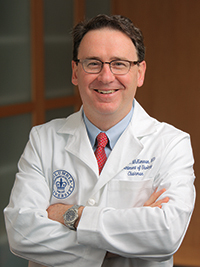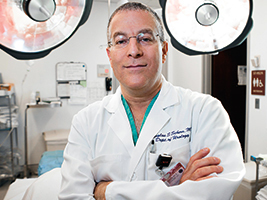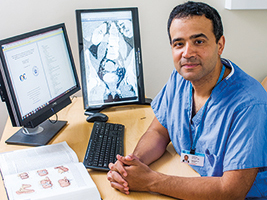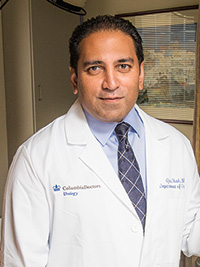|
|||||||||||||||||||||
A Multimodal Approach to the The Departments of Urology at NewYork-Presbyterian have long been at the forefront of medical, surgical, and research advances in the treatment of bladder cancer – a disease that is common and often lethal. Each program draws on strengths that complement the other to provide a full range of medical and surgical approaches and novel therapeutics that address a patient’s specific diagnosis. The Departments are also pursuing important research investigations to advance the means of early detection and more targeted therapies. “Over the last decade the treatment for invasive bladder cancer has evolved considerably,” says Douglas S. Scherr, MD, Clinical Director of Urologic Oncology at NewYork-Presbyterian/Weill Cornell Medical Center, who collaborates closely with colleagues in medical oncology, radiation oncology, and pathology to provide comprehensive and innovative care for patients with prostate, bladder, kidney, and testicular cancer. “With locally advanced bladder cancer most patients have a survival advantage if they receive a combination of chemotherapy plus surgery. Advances in robotic technology, along with scientific progress in our precision medicine program, have allowed us to direct therapy in unprecedented ways.” Role of Robotics Stage I bladder cancers that have grown into the connective tissue layer of the bladder wall but have not reached the muscle layer are typically treated with transurethral resection. If the cancer is high grade, if many tumors are present, or if the tumor is very large when it is first found, radical cystectomy may be recommended. “Removing the bladder and constructing a new bladder is a major operation,” says Dr. Scherr. “Nationwide literature associates this surgery with a 40 to 50 percent complication rate. When I started in this field I felt this was an area that could be improved upon drastically.” “Radical cystectomy is associated with a major long-term change in quality of life for both men and women. Bladder removal is an operation that most patients would prefer to avoid at all costs,” says James M. McKiernan, MD, Urologist-in-Chief, NewYork-Presbyterian/Columbia University Medical Center, and Chairman of the Department of Urology and Director of Urologic Oncology. “This surgery has multiple sexual side effects for males and females, urinary quality-of-life side effects, and a significant mortality risk. In men it involves prostate removal; in women it involves removal of the ovaries and uterus.” In 2005, Dr. Scherr began performing robotic surgery to remove bladders, drawing on his considerable experience in robotic prostatectomies. “To date, I’ve done close to 400 robotic cystectomies,” notes Dr. Scherr. “What we found, very interestingly, is that we’ve been able to reduce the complication rate by almost 25 percent. We have also found that robotic cystectomy accounts for 90 percent less blood loss compared to open bladder cancer surgery and much lower rates of blood transfusions.” According to Dr. Scherr, in studies performed at NewYork-Presbyterian/Weill Cornell, early results are very promising showing equality in safety and oncologic efficacy to the traditional open procedure. “Cystectomy is one of the surgeries that robotics is most adapted to,” says G. Joel DeCastro, MD, MPH, Assistant Professor at Columbia and an expert in both robotic and laparoscopic techniques for the treatment of urologic tumors of the bladder, kidney, and prostate. “The bladder sits in the narrow space of the pelvis, and the robot makes it easier to work in that small space. The robotic arms allow more precise movements of the instruments and a three-dimensional view.” Bladder cancer is typically a disease of the elderly, and Drs. Scherr and DeCastro have performed robotic cystectomy in patients in their late 70s, 80s, and even 90s. “We are now able to give patients who are not otherwise good surgical candidates an opportunity to benefit from the cure, which is removing the bladder,” says Dr. Scherr. Another benefit, particularly as it relates to younger individuals, is the ability to spare nerves and preserve sexual function and urinary control. “In addition to curing a lot of patients, we are able to focus on quality of life,” he says. Weill Cornell now has the daVinci Xi robotic surgical system. “The new Xi system enables us to perform complex multiquadrant surgery, and allows us to get up much higher in the abdominal cavity to do a more extensive lymph node dissection,” says Dr. Scherr.
Multidisciplinary Approaches to Bladder Preservation Dr. McKiernan has a particular interest and expertise in organ preservation and reconstructive surgery for patients with recurrent cancer or a high-risk diagnosis. His mission is not only to cure patients of bladder cancer, but also to preserve their bladders if possible. “During the last 10 years we have been exploring investigational agents to try to cure cancers that have not been controlled with BCG [Bacillus Calmette-Guérin therapy], an intravesical bacterial immunotherapy that is placed in the bladders of patients with high risk stage I cancer,” says Dr. McKiernan. “BCG has about a 50 to 60 percent cure rate. However, when it doesn’t work, most guidelines recommend that the bladder be removed. Our research team has discovered several alternative treatments that can control bladder cancer when BCG fails, allowing more patients to avoid major surgery.” In 2002, Dr. McKiernan and his colleagues began searching for a second line agent for BCG-resistant patients with a clinical trial testing docetaxel in 18 consecutive patients. The success of this trial, resulting in a 25 percent response rate and saving the bladders of one in four patients, launched the Columbia researchers into five consecutive intravesical therapy trials, including a current first-in-human study using three different drugs that are put into the bladder. Prior to testing these therapies in clinical trials, Dr. McKiernan partnered with basic scientists in the laboratory of Cory Abate-Shen, PhD, at the Herbert Irving Comprehensive Cancer Center at Columbia University to conduct corollary investigations in animal models. “In the past six years we have run two major, parallel pre-clinical drug experiments to figure out which drugs worked the best and then translate them into IRB-approved clinical trials,” says Dr. McKiernan. “We are monitoring and adjusting as we go. We might learn through our current trial that two of the three drugs are better than all three.” “Using combinations of therapies is a novel approach,” says Dr. DeCastro. “The delivery is exactly the same as for BCG – the drugs are administered to the bladder through a small catheter and the patient holds the solution for two hours before urinating. Because of drug interactions, patients undergo six weeks of treatment alternating each drug every other day. The idea is to have multiple treatments, not just a one-time shot. Systemic side effects are very rare.” With more advanced cases of stage II and III bladder cancer, Dr. McKiernan and his colleagues have shown that prior to surgery patients could receive intravenous chemotherapy designed to improve their survival by shrinking the tumor. “We have noticed that sometimes by doing that you shrink the tumor so much that it disappears and you get a complete response,” says Dr. McKiernan. “We took this approach with 32 patients and found an 85 percent cure rate with keeping the bladder, which is exactly the same as removing the bladder. To date 48 patients have been conservatively managed in this way and the data seems to be holding. Arguably, this is not the standard of care today, but it should be discussed with patients if there is no cancer remaining following neoadjuvant chemotherapy.” Dr. McKiernan explains to select patients that there is a 30 percent probability that the chemotherapy approach first could eliminate the cancer. A number of patients have opted to forego surgery after chemotherapy and are participating in what Dr. McKiernan describes as a “surveillance of the complete responder” program that involves periodic follow-up with cystoscopy. A recent surgical advancement employed at NewYork-Presbyterian/Columbia is photodynamic or fluorescent cystoscopy, a unique technology to detect and diagnose tumors in the bladder. Also known as Cysview®, this enhanced imaging procedure helps physicians find bladder tumors more easily than standard cystoscopy, which can miss some tumors that are too small to see with the naked eye. “When we look at a bladder and it looks totally normal, and then turn on the Cysview camera, the tumors light up like a fluorescent, undersea creature,” says Dr. McKiernan. “Then you turn the camera off again and they disappear. It’s very impactful.” “You can actually catch a lot of otherwise invisible tumors,” adds Dr. DeCastro. “It’s like night vision – you can visualize multiple things that were always there but you just couldn’t see them.” “Blue light cystoscopy has been proven in a large, randomized trial to improve cure rates by about seven to 10 percent,” adds Dr. McKiernan. “We use it for almost 15 to 20 percent of our patients; it’s an option and another tool.” Pursuing Genomic Research In 2015 NewYork-Presbyterian/Columbia was awarded a $300,000 basic science research grant from among 85 institutions around the world by the Bladder Cancer Advocacy Network (BCAN). “Our proposal involved sequencing small pieces of bladder cancer tissue in humans to try to determine different mutations that are driving the cancer,” says Dr. McKiernan, who also serves on the BCAN Scientific Advisory Board. That tissue is being studied in the laboratories of Dr. Cory Abate-Shen and Michael M. Shen, PhD, at the Herbert Irving Comprehensive Cancer Center. Dr. Shen specializes in organoid research in which clusters of cells of human tissue are recreated in a three-dimensional cell culture. “We hope to get to a point where a patient could have a sample taken, grow it in the lab in the form of an organoid, and test it against various, new drugs,” says Dr. McKiernan. “That information would then guide our decision in treating the patient with the drug that is most effective.” Dr. McKiernan notes that all drugs administered are evaluated with cystoscopy. “If we can make cystoscopy a little better, say 7 to 10 percent better by using a new dye, for example, we might be able to help the drugs save the bladder,” he says. “All of these approaches interact with one another in strange and complex ways that we don’t fully understand yet. But I want all of the tools we have on the table with the hope, eventually, of giving patients the best cure rate and the highest probability of walking out of the hospital with their bladder.”
Noted Urologist Named Chief of Endourology The Department of Urology at NewYork-Presbyterian/Columbia University Medical Center has further expanded its expertise with the appointment of Ojas Shah, MD, as Chief of the Division of Endourology and Director of the Comprehensive Kidney Stone Center. Dr. Shah, a specialist in the prevention and treatment of kidney stones, has also been appointed Professor of Urology at Columbia University College of Physicians and Surgeons. “We are thrilled to welcome Dr. Shah to NewYork-Presbyterian/ Columbia,” says James M. McKiernan, MD, Urologist-in-Chief, NewYork-Presbyterian/Columbia. “A nationally recognized leader in kidney stone disease, Dr. Shah offers our patients access to state-of-the-art urological care, including minimally invasive approaches, designed to improve both outcomes and comfort for patients. In addition, he heads our multidisciplinary comprehensive stone center, leading a team of nephrologists, nurses, and nutritionists.” In his new role, Dr. Shah leads the Hospital’s efforts in developing and performing minimally invasive procedures for urologic conditions such as urinary stone disease, ureteral injury, and upper urinary tract urothelial carcinoma. An expert in ureteroscopic surgery in which surgeons use highly precise instruments to operate without making an incision, he is skilled in using this technique in combination with a Holmium laser to treat kidney stones and upper urinary tract tumors. Dr. Shah’s clinical interests also include surgical and metabolic treatments of kidney stone disease, minimally invasive urologic surgery, ureteral strictures, ureteropelvic junction obstruction, ureteral/renal reconstructive surgery, and benign prostate hyperplasia. No Stone Unturned Kidney stones, which affect roughly one in 11 Americans, are associated with a wide variety of risk factors, including diabetes, hypertension, obesity, hyperparathyroidism, chronic inflammatory conditions of the bowel, and diet. In describing the Department’s new Comprehensive Kidney Stone Center, Dr. Shah emphasizes quick access that is available for patients. “Kidney stones can be very painful, and they need to be seen quickly, ideally without having to go to an ER,” he says. Collaboration is key to Dr. Shah’s goals for expanding the new service. “We are working closely with colleagues in nephrology, endocrinology, and radiology, and also bringing in nutrition services since some of our patients with stone disease have multiple medical problems that require specialized diets,” says Dr. Shah. A prolific researcher, Dr. Shah has conducted multiple studies in stone disease, including the use of silodosin to facilitate the passage of ureteral stones, investigations into flexible ureteroscopy for proximal ureteral and kidney stones, antimicrobial resistance patterns in cases of obstructive pyelonephritis secondary to stones, as well as robotic-assisted laparoscopic upper urinary tract reconstruction. At Columbia, Dr. Shah continues his research endeavors, starting collaborations with researchers in the Divisions of Nephrology and Endocrinology and the Columbia Genome Center on the genetics of stone disease. “There has been limited research to date on the genetics of stone disease,” says Dr. Shah. “Genetic studies have been done on rare kidney stones, and we have been able to identify how those conditions are created. But extrapolating that data and translating it into something that can be used clinically has been somewhat limited thus far. We are looking to identify certain genes that make one more prone to making kidney stones, and hopefully provide information that will help prevention and treatment of this condition.” As a member of the R.O.C.K. Society, a forum for scientific discourse focused on the basic mechanisms involved in human urinary stone formation, Dr. Shah is collaborating with other urologists and nephrologists investigating stone disease and minimally invasive surgery. Dr. Shah is also a founding member of the Endourologic Disease Group for Excellence (EDGE) research consortium which is a collaboration of 12 major North American academic institutes interested in advancing the management of stone disease. “Together we have the ability to conduct trials which will hopefully have more meaningful impact in our discipline,” he says. “We have already completed one clinical trial, with several trials ongoing or just starting.” He serves on the editorial board for the Journal of Urology, is an Associate Editor of Taneja’s Complications of Urologic Surgery (Fifth Edition, Elsevier), and the author of over 75 peer-reviewed articles, review articles, case reports, and book chapters. Receiving his medical degree from the Honors Program in Medical Education at Northwestern University School of Medicine, Dr. Shah then completed a residency in urology at New York University School of Medicine, followed by fellowship training in endourology and laparoscopy at Wake Forest University School of Medicine. Previously, Dr. Shah was the Director of the Endourology and Stone Disease Program and Associate Professor of Urology at New York University Langone Medical Center. He additionally served as Chief of Urology at Bellevue Hospital while at NYU and was the Residency Program Director for Urology at NYU School of Medicine. At Columbia, Dr. Shah is spearheading a fellowship in stone disease and minimally invasive surgery that is expected to begin in July 2016. “I want to train residents and fellows at a high level,” he says. “Other major training programs concentrate on kidney stone surgery, but they do not always include the metabolic aspects of the disease, as well as the ability to collaborate with the prolific group of researchers that Columbia has on its faculty. We want to be one of the leaders in that educational realm.”
|
|||||||||||||||||||||
|
|||||||||||||||||||||









